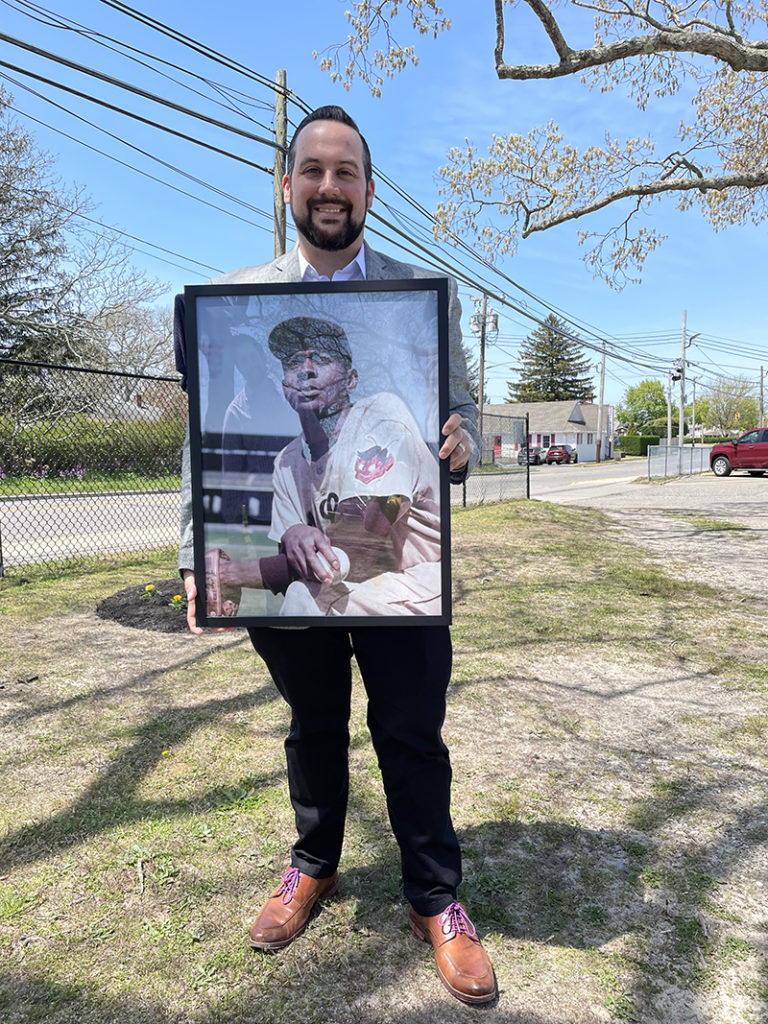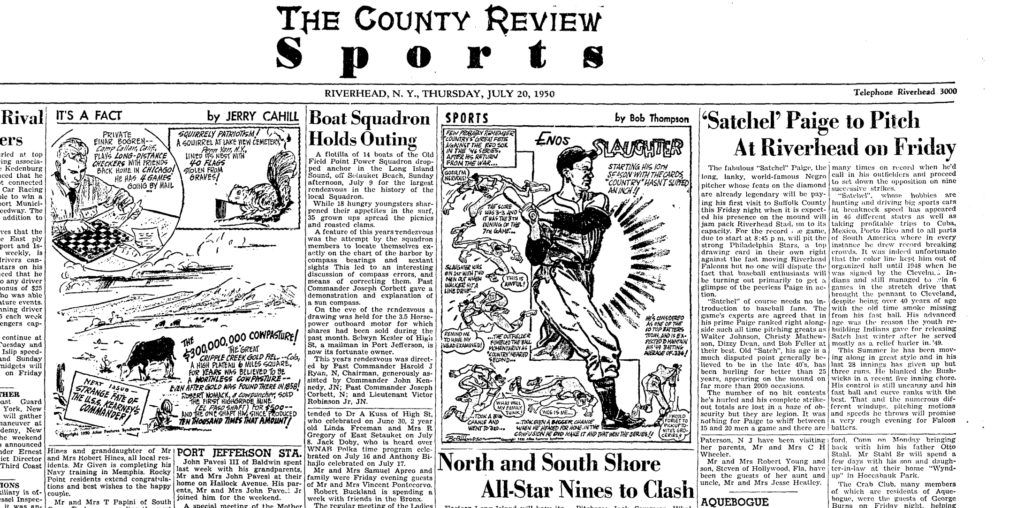Historic marker unveiled, commemorating night baseball legend Satchel Paige played in Riverhead

A forgotten piece of Riverhead history has been nailed down and marked.
Sometimes history can be found in the darnedest places — like your own backyard. That was the case for Riverhead when Fabio Montella’s research found that the late, great Satchel Paige pitched in a baseball game at the former Wivchar Stadium in Riverhead in 1950. That event was commemorated Thursday with the unveiling of a historical marker erected by the Suffolk Sports Hall of Fame.
The marker was placed at the Pulaski Sports Complex, near the Riverhead Central School District offices alongside Osborne Avenue, within a fly ball of the Riverhead High School baseball team’s home field. That site is believed to be about where Wivchar Stadium was located and where Mr. Paige pitched in a barnstorming game for the Philadelphia Stars against the Riverhead Falcons.
“I think it’s absolutely amazing,” Riverhead’s superintendent of schools, Dr. Augustine Tornatore, said following the ceremony. Dr. Tornatore called the site “sacred ground.”
The blue marker, outlined in red with white lettering, reads:
“WIVCHAR STADIUM
“LOCATION OF BASEBALL FIELD WHERE HALL OF FAME PITCHER SATCHEL PAIGE PLAYED ON JULY 21, 1950.
“SUFFOLK SPORTS HALL OF FAME, 2022”
Nearly 72 years ago, Mr. Paige was the star attraction at Wivchar Stadium for a magical night in which the Stars won, 10-5, before a reported record stadium crowd of 6,155. Carl Yastrzemski Jr., like Mr. Paige a future Hall of Famer, was a 10-year-old batboy for the Falcons at the game and saw his father bat against the legend.
Prior Coverage: The night Satchel played in Riverhead
Mr. Montella, assistant professor of library services and history for Suffolk County Community College’s Eastern Campus in Riverhead, shed light on this piece of history. He said his curiosity was stirred when he read an interview by Mr. Yastrzemski in which the Bridgehampton native and ex-Boston Red Sox great spoke about his memories of that game.
“So I took it upon myself to research this and try to put this picture together, try to find out what that day, what that event was like,” Mr. Montella said. “As I start to dig and do more research in the archives, databases and even through interviews, I find out some very interesting pieces of the puzzle.”
That game was played just three years after Jackie Robinson broke Major League Baseball’s color barrier. Mr. Paige had a remarkable playing career that spanned five decades, starting with the Negro Leagues in the 1920s. He made his MLB debut in 1948, playing two seasons with the Cleveland Indians before then spending three seasons with the St. Louis Browns and making a one-game appearance for the Kansas City Athletics in 1965.
Mr. Paige’s MLB numbers over six years show a 28-31 record and 3.29 ERA, according to baseball-reference.com, but those statistics aren’t reflective of his greatness. Negro Leagues statistics were incomplete at best. Mr. Paige claimed he kept his own records and pitched in more than 2,500 games, winning 2,000 or more, with 250 shutouts, according to biography.com.
In 1971, Mr. Paige became the first Negro Leagues player to be inducted into the National Baseball Hall of Fame. Mr. Yastrzemski followed him to Cooperstown in 1989.
On that special night in Riverhead in 1950, Mr. Paige worked three scoreless innings, with five strikeouts and no walks.

Bob Burns, covering the game for the Riverhead News-Review, reported that Mr. Paige “seeming to thoroughly enjoy himself, was far too fast and tricky for the locals in his stint ©” Mr. Burns wrote, “All in all, he gave a masterful performance without seeming to work too hard.”
Constantine Ricci, who played third base for the Falcons in that game, didn’t strike out often back in those days. He recalled his only plate appearance against Mr. Paige.
“I remember every pitch,” he told the Riverhead News-Review in a phone interview from his Dallas home last year. “You know why? Because it was only three pitches.”
Strike one. Strike two. Strike three.

Thursday’s ceremony was attended by school officials, members of Riverhead’s baseball program and others.
Riverhead varsity baseball coach Rob Maccone said, “I never knew of any of this stuff going on until recently.”
Mr. Maccone, accompanied at the ceremony by two of his players, Jaylen Harding and Aaron Miller, was asked how many of his young players knew who Mr. Paige was.
“Not many,” he said. “We were walking over here. I kind of had to give these two guys a little bit of a reason why what’s going on, the significance of it. They didn’t know who he was.”
When it was pointed out that the current Riverhead team plays in the shadow of some of baseball’s best, Mr. Harding said: “We get to play on the same field that two legends played on. That’s pretty cool.”
Mr. Miller appreciated the significance of the event, saying, “I’m just happy to be here for this.”
In his remarks during the ceremony, Suffolk Sports Hall of Fame executive director Chris Vaccaro said: “I think it’s really special that there’s a high school baseball field in the same spot where there was a stadium that impacted this community. So if you think about why this all matters, it’s really about community. And at that time 70 years ago, it was a gathering place for the community to come and relax and hang out after work, to kick back and enjoy our pastime. And here, this same spot is a location for educational advancement through athletics in literally the same spot. So I’m so happy that there’s a baseball field here.”
Speaking to those in attendance, Mr. Montella said: “I just want to stress the importance of this history as local Long Island history. And this is something that my students at Suffolk County Community College have come to appreciate. Some of them have continued to research baseball on Long Island. I have students that are researching the civil rights movement on Long Island, other students that are researching the change of suburbia on Long Island. They’re realizing that local Long Island history, it’s in our backyard and it’s the building block that holds this more broader national or even global history that we have. I just want to say today that the next time you hear the word history, where you want to find out what happened in the past, don’t run to a textbook right away. Don’t even jump on the internet right away. Look in your own backyards because I guarantee you the history you’ll find there will surprise you and it will really teach you where we come from and why we are who we are.”








